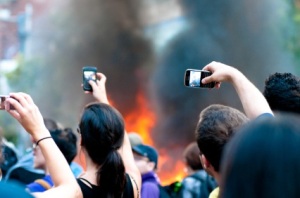 By Patrice Cloutier, Strategic communications professional and member of the Agnes + Day Crisis Intelligence Team.
By Patrice Cloutier, Strategic communications professional and member of the Agnes + Day Crisis Intelligence Team.
One of the characteristics of social convergence is the omnipresence of mobile devices equipped with video cameras. It’s how news is made today. As we know, this puts tremendous pressure on organizations to respond quickly when things go south.
Another interesting aspect is that, if everyone has the opportunity to break a story, anyone working for YOU can become the subject of that story. Which leads us to ask: What kind of training do THEY have?
It’s no longer sufficient to simply rely on the professionals to defend your reputation. Any organization with public-facing staff, field workers – any enterprise really – must now have a very basic media relations/crisis communications program for all of its personnel.
This starts with a common sense approach. Your employees are your representatives and they are expected to behave decently, with respect and compassion. (This is something that may have been temporarily forgotten by an employee at a large Canadian retailer).
So what are the basics here?
- What should your staff do if any of them get approached by the media? What simple holding statement or referring lines are they taught to use – or do you just instruct them to clam up?
- What kind of decentralization or autonomy do you want to give your staff? Are they free to talk about their area of expertise as long as they stay within those parameters?
- Do these rules apply only to “traditional” media or do they apply to anyone armed with a cellphone or digital camera?
- How are your professional communications staff set up to support your frontline people?
News is now made in a totally different way than it was just a few years back. Speed is the name of the game and your reputation can get mortally wounded in mere minutes.
The key thing to remember here is that your staff is your greatest asset. They will represent you well if they’re properly taken care of, trained and motivated. They live it every day. They can speak from the heart. All of this carries weight and can be a powerful way to convey your organization’s messaging. And it can really boost your reputation.
It’s simple: Hiding won’t work, but empowerment does!
Patrice Cloutier is currently Team Lead for strategic communications in the Communications Branch of the Ontario Ministry of Community Safety and Correctional Services. As such, he plays a key role in the planning and delivery of emergency information at the provincial level and in crisis communications planning. Patrice spent close to 10 years as a reporter and broadcaster with the Canadian Broadcasting Corporation/Société Radio-Canada and as a freelance journalist. He’s an avid blogger and social media enthusiast. Connect with Patrice on Twitter.

Great points. In my opinion, this is part of the reason why it is so important for communications / PR professionals to become the educators within an organization to mobilize ambassadors / spokespeople.
Nice read Patrice , its so true and now the journalist's job is more challenging but also with the development of Smartphone and when everyone have their mobile devices to shoot the event or some happening computation is so high. A lot of journalists have the better PR in their markets and they always have a great news so the demand of PR is so high that without it you are unable to compete in the journalist markets. Get the best training course that will help you to be the best in your journalism activities.